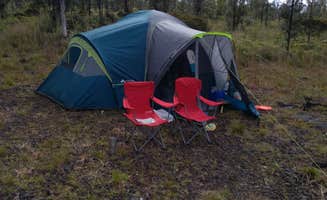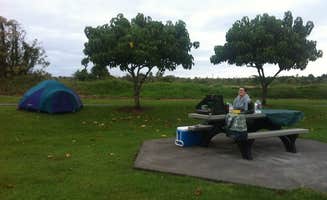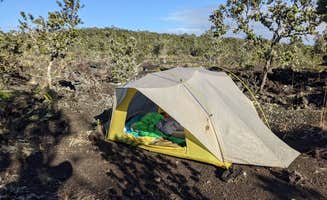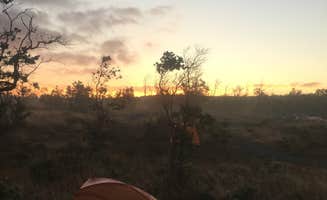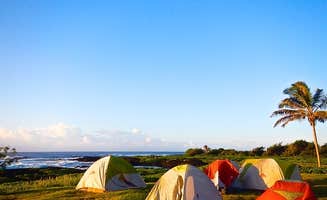Tent camping near Hawaiian Paradise Park offers both tropical and volcanic landscapes at elevations ranging from sea level to 4,000 feet in Hawaii Volcanoes National Park. Campers should prepare for significant microclimates, with coastal areas reaching 90°F during the day while higher elevation sites can drop below 50°F at night. Rainfall patterns vary dramatically across this region, requiring waterproof gear even during traditionally dry periods.
What to do
Sea turtle watching: Head to Wild Blue Water Ranch where campers can observe marine life from the property. "One of the highlights was our sea turtle watching from the point where we saw at least ten turtles feeding and swimming in the crystal clear waters," reports one visitor.
Stargazing: The dark skies at night provide exceptional viewing opportunities, especially at higher elevations. At Kulanaokuaiki Campground, a camper noted, "Right before dawn the skies cleared up and there were millions of stars. They looked so close that you could reach out and grab one."
Fruit harvesting: Many campsites feature tropical fruit trees accessible to guests. At Mango 🥭 Hale, "the property is covered in fruit trees" according to visitors, offering a unique foraging experience during your stay.
Hiking lava fields: The volcanic landscape provides distinctive terrain for exploration. "We hiked-in across extensive lava flows and through sections of tropical rainforest," reports a visitor to Napau Crater backcountry camp, noting that "hiking across the lava flows offers no discernable trail except for the regularly spaced ahu stone piles(cairns)."
What campers like
Hot springs and water features: The volcanic activity creates natural hot springs and water features throughout the region. A camper at Kolekole Gulch Park mentioned, "There was also some great small cliffs that we could jump off of- the whole family loved doing this."
Secluded camping spots: For those seeking privacy, many areas offer isolation despite proximity to roads. At Kulanaokuaiki Campground, a camper observed, "This campground is nice and secluded. We were the only people there."
Wildlife viewing: Beyond marine life, the area hosts diverse bird species and other wildlife. At Arnotts Lodge, a visitor reported, "So many birds and other loud creatures singing all night long."
Accessibility options: Some campgrounds have made efforts to accommodate all visitors. One camper at Kulanaokuaiki noted, "There are 8 campsites and actually it's pretty cool that 2 of the sites are wheelchair accessible, I'd never really seen that before."
What you should know
Water availability: Many tent sites require completely self-sufficient water planning. At Kulanaokuaiki Campground, "There is no water available at the campground so be prepared. Water is available at the visitor's center up the hill about 7 miles away."
Temperature variations: Pack for significant temperature swings, especially at volcanic sites. "There was an immense amount of fog surrounding the area and it was very cold," reports one Kulanaokuaiki camper about nighttime conditions.
Road conditions: Access roads to some sites may be challenging. "The access road is off of the Chain of Craters Drive and it seems to go on forever through the lava fields. The road is not great, but we were in a little car and did not have any issues," notes a visitor about reaching Kulanaokuaiki.
Permit requirements: Backcountry camping requires permits obtained in advance. A visitor reported, "You can camp in most areas of the park as long as you have a back country permit. The permits are free and you apply at the ranger's station near the visitor's center."
Tips for camping with families
Timing for popular sites: Visit high-traffic areas early to avoid crowds. "If you want to do the touristy hikes (which are generally short and easy, but offer great things to see), do them early in the morning, (get started by 8:00am) and you will beat the tour busses," advises a visitor to Hawaii Volcanoes National Park.
Sun protection: Lava field camping offers minimal shade. "During the day you are really exposed and it gets hot... Make sure and bring lots of water (you'll want it)," warns a camper at Kulanaokuaiki.
Grocery planning: Limited supplies are available near some camping areas. At Lava Rock Glamping, visitors should know that "once you get to Volcano (the town VNP is located) there is one small gas station store and a true value hardware (which has a little bit of everything)."
Educational opportunities: Take advantage of ranger programs in national park areas. Visitors report "learning about the myths and legends surrounding the volcanoes" and "attending intriguing ranger programs" as highlights of their camping experience.
Tips from RVers
Size limitations: Most tent camping sites near Hawaiian Paradise Park are not suitable for large RVs. None of the reviewed campgrounds list big-rig-friendly accommodations.
Utility connections: Limited electrical hookups exist at select sites. At Mango Hale, electric hookups are available for tent campers but no water or sewer connections are provided.
Supply refills: Plan carefully for water and supplies. The distances between facilities can be significant, with one camper noting, "For something specialized like camping gas we had to drive to a hardware store outside of Hilo."


